
- •Reznichenko Valery
- •Lecture8. Normalization theory
- •Lecture8. Normalization theory
- •Lecture8. Normalization theory
- •Lecture8. Normalization theory
- •Lecture8. Normalization theory
- •Lecture8. Normalization theory Sunday 7 July 2019
- •Lecture8. Normalization theory
- •Lecture8. Normalization theory
- •Lecture8. Normalization theory
- •Lecture8. Normalization theory
- •Lecture8. Normalization theory Sunday 7 July 2019
- •Lecture8. Normalization theory
- •Lecture8. Normalization theory
- •Lecture8. Normalization theory
- •Lecture8. Normalization theory
- •Lecture8. Normalization theory
- •Lecture8. Normalization theory
- •Lecture8. Normalization theory
- •Lecture8. Normalization theory
- •Lecture8. Normalization theory
- •Lecture8. Normalization theory
- •Lecture8. Normalization theory
- •Lecture8. Normalization theory
- •Lecture8. Normalization theory
- •Lecture8. Normalization theory
- •Lecture8. Normalization theory
- •Lecture8. Normalization theory
- •Lecture8. Normalization theory
- •Lecture8. Normalization theory
- •Lecture8. Normalization theory
- •Lecture8. Normalization theory
- •Lecture8. Normalization theory
- •Lecture8. Normalization theory
- •Lecture8. Normalization theory
- •Lecture8. Normalization theory
- •Lecture8. Normalization theory
- •Lecture8. Normalization theory
- •Lecture8. Normalization theory
- •Lecture8. Normalization theory
- •Lecture8. Normalization theory Sunday 7 July 2019
- •Lecture8. Normalization theory
- •Lecture8. Normalization theory

Lecture8. Normalization theory |
Sunday 7 July 2019 |
Logical inference of functional dependencies
Let’s R have set of functional dependencies F and the dependence А С that is not in F. Dependence А С is logically implied by (or logically deduced from) F if it may be inferred from F with the help of
functional dependencies axioms.
For example, if we have the relation R(A, B, C) and F contains the dependence А С, then the following dependences are logically implied from F:
|
|
|
|
|
(А, С) В |
- continuation property is applied; |
|
|
(А, С) (В, С) |
- augmentation property is applied . |
|
|
|
|
|
CSF NAU |
11 |

Lecture8. Normalization theory |
Sunday 7 July 2019 |
Closure, completeness, equivalence and minimal cover of FD
Let’s relation R have set of functional dependencies F. The set of all functional dependencies logically implied by F is called (logical)
closure of F. It is notified as F+. It is obvious, that F F+ и F+ = F++.

 Set of functional dependencies F is complete if F = F+.
Set of functional dependencies F is complete if F = F+.
Two sets of dependencies F and G are (logically) equivalent if F+ = G+.
Lets given sets of functional dependencies F and G such that G F. G is a cover of F if G+ =F+. If G is minimal then G is called basis of dependencies of F or minimal cover.
NOTE: Minimal cover isn't necessarily unique.
CSF NAU |
12 |

Lecture8. Normalization theory |
Sunday 7 July 2019 |
FD и сущности предметной области
Thesis. If application domain contains functional dependence А В there exists class of the entities that consist of attributes (A, B). More over in this class set of attributes
A is an unique identifier of entities of this class (key) and B are properties of these entities .
If А В1, А В2, …, А Вn, the exists class of entities with attributes(А, В1,…,Вn), where А – unique identifier and В1,…, Вn – are ordinary attributes.
This thesis gives formal basis for identifying entities in AD.
CSF NAU |
13 |
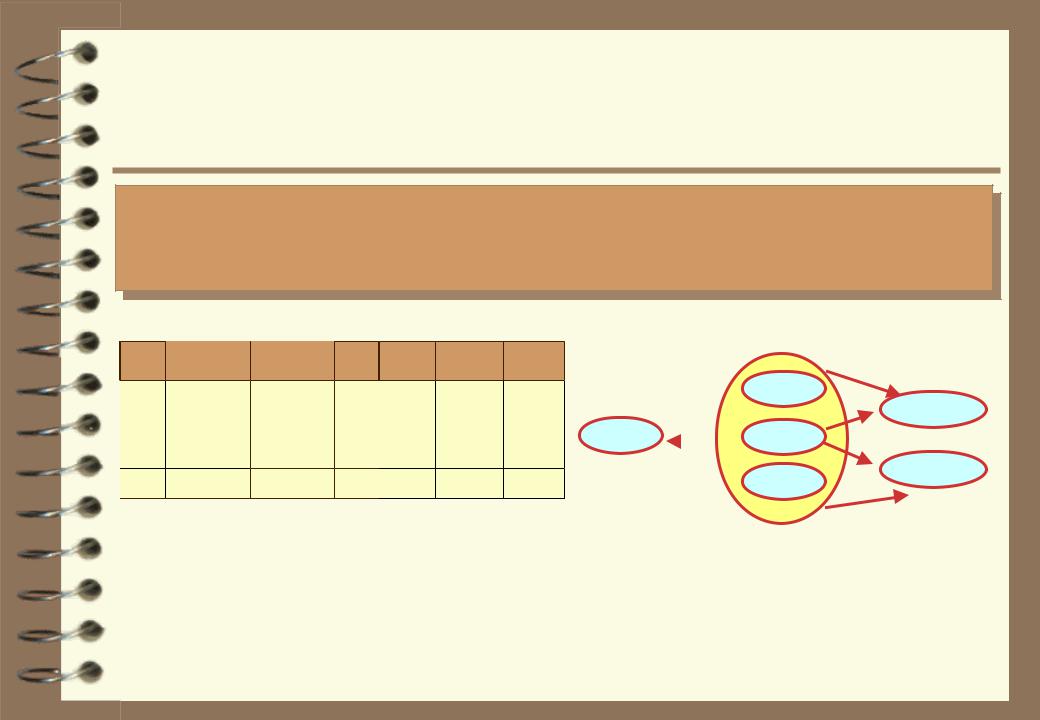
Lecture8. Normalization theory Sunday 7 July 2019
Not full (partial) functional dependencies and second normal form (2NF)
Let’s given relation with schema R(A, B, C). Functional dependence R.A R.B is full if B does not depends functionally from any С А that does not contained in B.
CUSTOMER-PURCHASE |
|
|
|
|
|
Candidate |
|
||
|
|
|
|
|
key |
|
|||
CN |
NAME |
CITY … |
PN |
DATE |
Q-TY |
|
|
|
|
|
|
PN |
|
||||||
1 |
Ivan |
Kiev |
1 |
21.01 |
20 |
|
|
NAME |
|
|
|
|
|||||||
1 |
Ivan |
Kiev |
2 |
23.01 |
17 |
Q-TY |
|
CN |
|
|
|
||||||||
2 |
Peter |
Odessa |
1 |
26.10 |
25 |
|
CITY |
||
|
|||||||||
|
|
|
|||||||
3 |
John |
Kiev |
2 |
29.01 |
20 |
|
|
DATE |
|
|
|
|
|||||||
Attribute Q-TY depends fully from (PN, CN, DATE)
Attributes NAME and CITY depends fully from CN
Attributes NAME and CITY depends not fully (partially) from (PN, CN, DATE)
CSF NAU |
14 |
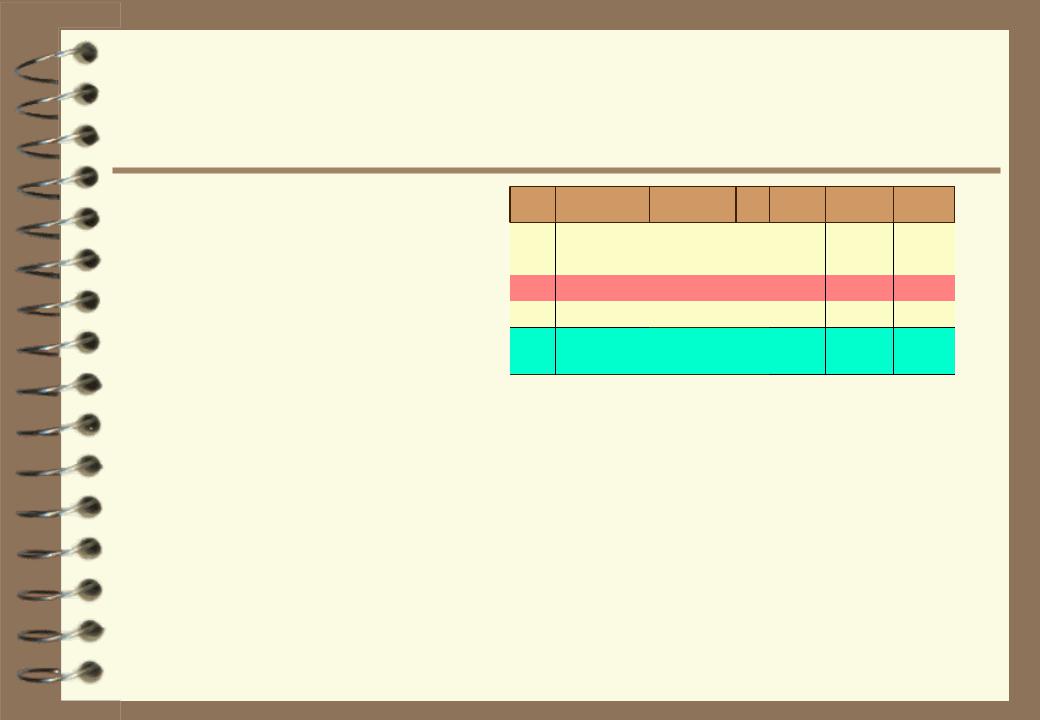
Lecture8. Normalization theory |
Sunday 7 July 2019 |
Anomalies of insertion, deleting and updating when not full FD exist
CUSTOMER-PURCHASE CN |
NAME |
CITY … |
PN |
DATE |
Q-TY |
|
1 |
Ivan |
Kiev |
1 |
21.01 |
20 |
|
1 |
Ivan |
Kiev |
2 |
23.01 |
17 |
|
2 |
Peter |
Odessa |
1 |
26.10 |
25 |
|
3 |
John |
Kiev |
2 |
29.01 |
20 |
|
4 |
Ann |
Kherso |
? |
? |
? |
|
n |
||||||
|
|
|
|
|
Update anomalies. When changing customer city it is necessary to remember that information about customers may be duplicated.
Inset anomalies. When it is necessary to enter information about new customer (Ann) we may do it only when it will do purchase.
Delete anomalies. On deleting information about purchase of Ann we have to delete information about this customer.
CSF NAU |
15 |

Lecture8. Normalization theory |
Sunday 7 July 2019 |
The second normal form (2NF)
Relation is in the second normal form (2NF) if it is in the first normal form and all its nonprimary attributes are depend fully from candidate key .
Теорема (Хита). The relation R with attributes А, В, С , where
R.A R.B, is equal to natural join of the projections R[A, B] and R[A, C].

 Such splitting is called binary decomposition.
Such splitting is called binary decomposition.
Algorithm of reduction to 2NF. Given relation R with set of attributes M. If in R there is not full functional dependence R.A R.B of non primary attribute B from a candidate key A, the relation R is decomposed into the following two relations: R [A, B] and R [M - B]. If the resulting relations are still not in the second normal form, the mentioned algorithm is applied to these relations again.
CSF NAU |
16 |
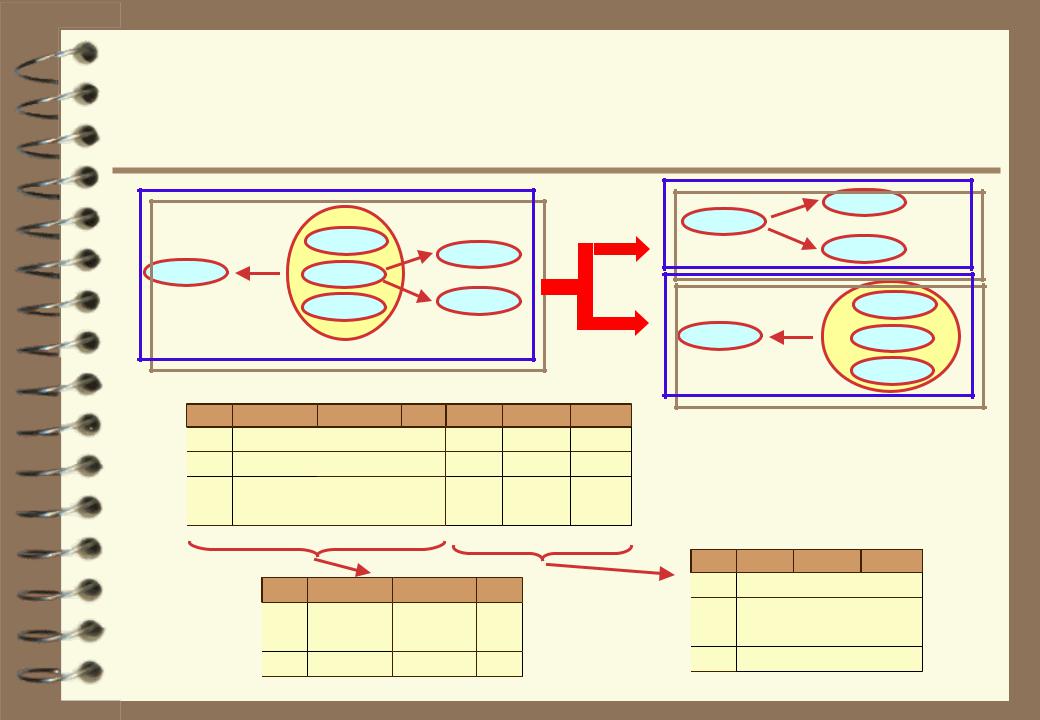
Lecture8. Normalization theory |
Sunday 7 July 2019 |
Example of reduction to the 2NF
PN
NAME
Q-TY |
CN |
DATE CITY
CUSTOMER-PURCHASE
CN |
NAME |
CITY |
… PN |
DATE |
Q-TY |
1 |
Ivan |
Kiev |
1 |
21.01 |
20 |
1 |
Ivan |
Kiev |
2 |
23.01 |
17 |
2 |
Peter |
Odessa |
1 |
26.10 |
25 |
3 |
John |
Kiev |
2 |
29.01 |
20 |
CUSTOMER |
CN |
NAME |
CITY ... |
|
|
|
1 |
Ivan |
Kiev |
|
|
|
2 |
Peter |
Odessa |
|
|
CSF NAU |
3 |
John |
Kiev |
|
|
|
|
|
|
|
NAME
CN
CITY
PN
QiTY |
CN |
DATE
PURCHASE
CN |
PN |
DATE |
Q-TY |
|
1 |
1 |
21.01 |
20 |
|
1 |
2 |
23.01 |
17 |
|
2 |
1 |
26.10 |
25 |
|
3 |
2 |
29.01 |
20 |
17 |
|
|
|
|

Lecture8. Normalization theory |
Sunday 7 July 2019 |
Example of reduction to the 2NF - Summary
Source relation contains information from 2 entities, every resulting relations contain information about one entity each.
Resulting relations do not contain anomalies of deletion, inserting and updating.
Source relation can be restored from resulting relations with the help of natural join.
Such decomposition do not lose functional dependencies. They may be restored from decomposed relations.
CSF NAU |
18 |
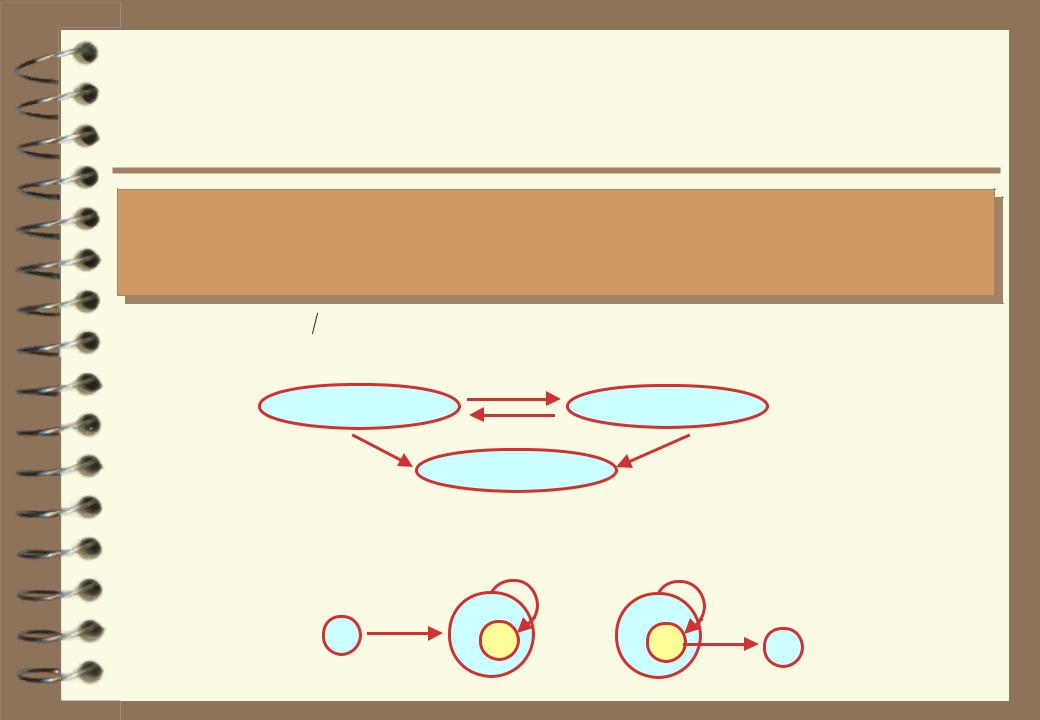
Lecture8. Normalization theory |
Sunday 7 July 2019 |
Transitive dependencies and the Third Normal Form (3NF)
Relation R has transitive dependence if it has such attributes (set of attributes) А, В, С, С В, В А that:
АВ, В С; at the same time В  А
А
1)Condition В А is necessary in order to exclude trivial transitive dependence like this:
Student card No |
Tax ID |
Student name
2)Conditions С В, В А are necessary to exclude the following trivial transitive dependencies:
А |
В |
А |
|
С |
В |
С |
CSF NAU |
19 |
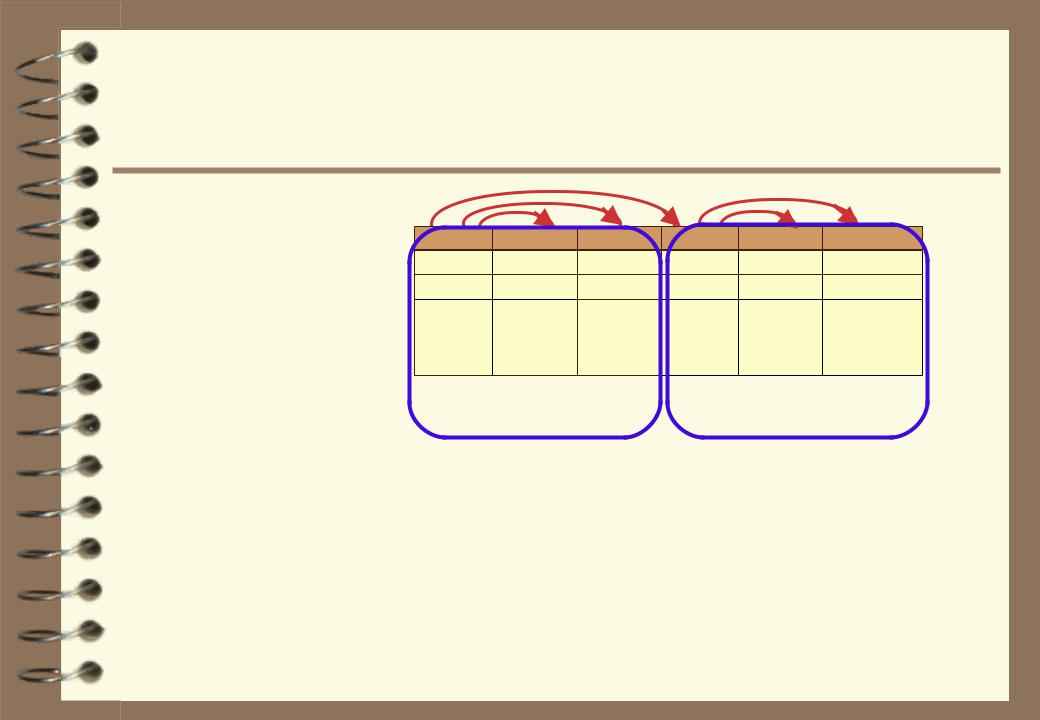
Lecture8. Normalization theory |
Sunday 7 July 2019 |
Anomalies of insertion, deleting and updating when transitive FD exist
DEPARTMENT-FACULTY DepNo |
DName |
DHead |
FacNo |
FName |
FDean |
1 |
DBMS |
John |
1 |
CSF |
Ann |
2 |
CAD |
Peter |
1 |
CSF |
Ann |
3 |
SE |
Sam |
1 |
CSF |
Ann |
4 |
CAM |
Dick |
2 |
CTF |
Dave |
5 |
OS |
PL |
2 |
CTF |
Dave |
DEPARTMENT entities |
FACULTY entities |
||||
Availability transitive dependencies in a relation means the relation contains information from more that one entity.
As a result such relations imply anomalies of insertion, deletion, updating.
CSF NAU |
20 |
